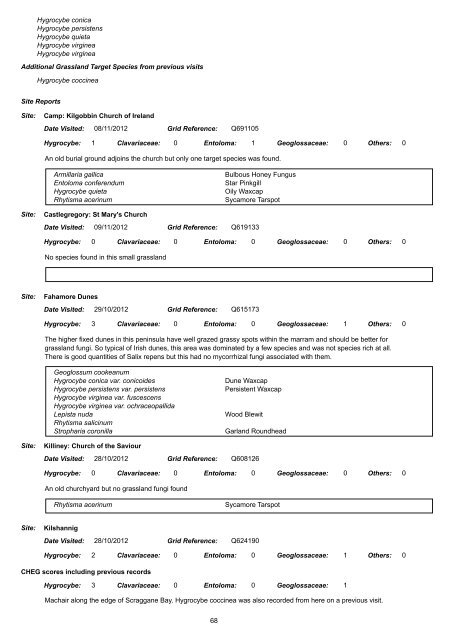North Kerry Waxcap Survey 2012 - the Northern Ireland Fungus Group
North Kerry Waxcap Survey 2012 - the Northern Ireland Fungus Group
North Kerry Waxcap Survey 2012 - the Northern Ireland Fungus Group
You also want an ePaper? Increase the reach of your titles
YUMPU automatically turns print PDFs into web optimized ePapers that Google loves.
Hygrocybe conica<br />
Hygrocybe persistens<br />
Hygrocybe quieta<br />
Hygrocybe virginea<br />
Hygrocybe virginea<br />
Additional Grassland Target Species from previous visits<br />
Hygrocybe coccinea<br />
Site Reports<br />
Site: Camp: Kilgobbin Church of <strong>Ireland</strong><br />
Date Visited: 08/11/<strong>2012</strong><br />
Grid Reference: Q691105<br />
Hygrocybe:<br />
1<br />
Clavariaceae:<br />
0<br />
Entoloma:<br />
An old burial ground adjoins <strong>the</strong> church but only one target species was found.<br />
Armillaria gallica Bulbous Honey <strong>Fungus</strong><br />
Entoloma conferendum Star Pinkgill<br />
Hygrocybe quieta Oily <strong>Waxcap</strong><br />
Rhytisma acerinum Sycamore Tarspot<br />
Site: Castlegregory: St Mary's Church<br />
Date Visited: 09/11/<strong>2012</strong><br />
Grid Reference: Q619133<br />
Hygrocybe:<br />
0<br />
Clavariaceae:<br />
No species found in this small grassland<br />
Site: Fahamore Dunes<br />
Entoloma:<br />
Date Visited: 29/10/<strong>2012</strong><br />
Grid Reference: Q615173<br />
Hygrocybe:<br />
3<br />
Clavariaceae:<br />
0<br />
0<br />
Entoloma:<br />
1<br />
0<br />
0<br />
Geoglossaceae:<br />
Geoglossaceae:<br />
Geoglossaceae:<br />
0<br />
0<br />
1<br />
O<strong>the</strong>rs: 0<br />
O<strong>the</strong>rs: 0<br />
O<strong>the</strong>rs: 0<br />
The higher fixed dunes in this peninsula have well grazed grassy spots within <strong>the</strong> marram and should be better for<br />
grassland fungi. So typical of Irish dunes, this area was dominated by a few species and was not species rich at all.<br />
There is good quantities of Salix repens but this had no mycorrhizal fungi associated with <strong>the</strong>m.<br />
Geoglossum cookeanum<br />
Hygrocybe conica var. conicoides Dune <strong>Waxcap</strong><br />
Hygrocybe persistens var. persistens Persistent <strong>Waxcap</strong><br />
Hygrocybe virginea var. fuscescens<br />
Hygrocybe virginea var. ochraceopallida<br />
Lepista nuda Wood Blewit<br />
Rhytisma salicinum<br />
Stropharia coronilla Garland Roundhead<br />
Site: Killiney: Church of <strong>the</strong> Saviour<br />
Date Visited: 28/10/<strong>2012</strong><br />
Grid Reference: Q608126<br />
Hygrocybe:<br />
0<br />
Clavariaceae:<br />
An old churchyard but no grassland fungi found<br />
Site: Kilshannig<br />
0<br />
Entoloma:<br />
Rhytisma acerinum Sycamore Tarspot<br />
Date Visited: 28/10/<strong>2012</strong><br />
Grid Reference: Q624190<br />
Hygrocybe:<br />
Clavariaceae:<br />
CHEG scores including previous records<br />
2<br />
0<br />
Entoloma:<br />
0<br />
0<br />
Geoglossaceae:<br />
Geoglossaceae:<br />
Hygrocybe: 3 Clavariaceae: 0 Entoloma: 0 Geoglossaceae: 1<br />
Machair along <strong>the</strong> edge of Scraggane Bay. Hygrocybe coccinea was also recorded from here on a previous visit.<br />
68<br />
0<br />
1<br />
O<strong>the</strong>rs: 0<br />
O<strong>the</strong>rs: 0


